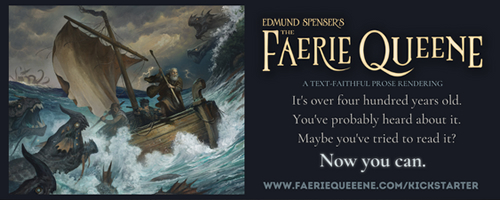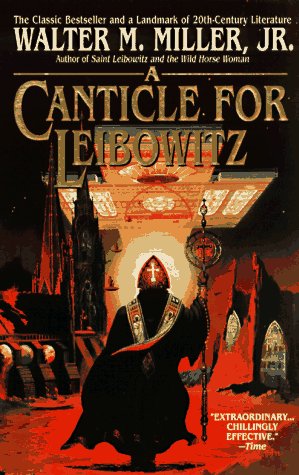‘A Canticle For Leibowitz’ Is A Transcendent Dystopia
A canticle is “a song that has words from the Bible and that is used in Christian church services.”1 A Canticle for Leibowitz is a book with words from an imagined liturgy of a future saint, mixed with the grimy world of sinners seeking God, useful for anyone’s thoughtful reading.2
I learned about the book via a discussion on the intersection of science fiction and Christianity, and it certainly hugs that line with an unflinching dedication to the best of both traditions.
In reality I’d classify this book as three novelas bound together by a central thread of continuity.
The first third of the book takes place just after a major catastrophe has plunged humanity back into a medieval setting. The second third is set several hundred years later during a second Renaissance. And the last third is set even further into the future during a new modern age that is on the brink of annihilating itself.
During each era an order of monks venerate the memory of a new martyr–and later a saint–Leibowitz. They continue his work of preserving the world’s knowledge while fighting the ever present-darkness that comes from without and within.
The sparse writing style, shifting viewpoints, and philosophical discussions don’t make Canticle an easy read; I had a hard time cracking the first few chapters before I settled into the author’s rhythm. No action scenes, romantic subplots, or quirky comics are here to lighten the mood, and the post-nuclear-war setting doesn’t shy from the brutality such a world might produce. But if you ever wished the characters of Asimov or Bradbury had discussed spiritual matters with the same verve as scientific discovery, this book is one for you.
In the story, real human longings are expressed in the shared logos of science and theology, while the need for a deeper Truth beyond mere facts is shown time and again. The earliest monks are focused more on survival than anything else, cut off from the very civilization they seek to preserve. Later the order is sought by a world newly awakened to a hunger for knowledge and yet growing no wiser from its gathering–a reoccurring theme.
Yet my favorite character’s struggles occurred in the novel’s final, bleakest section. Just as this era is a culmination of all that came before, the Abbot Zerchi is a hodgepodge of so many competing ideas: reverent and impatient, impulsive and contemplative, a man just as apt to tinker with his computer as he is to fight against evil–sometimes with more gusto than foresight. In that respect Abbot Zerchi is a bit like St. Peter himself, but Zerchi is also a representation of St. Paul’s lament on doing that which he does not wish to do, even as his world rushes to an apocalypse no one claims to want. His duty in the hardest of all, “to wait for the end and pray that it would not come.” He provides bold leadership to his flock as the world around them collapses, balancing mercy and justice in the hardest of decisions, facing his own garden of Gethsemane with real agony and a glimpse of the divine.
I don’t know the personal beliefs of Canticle‘s author, Walter M. Miller Jr. And no doubt some readers may find it odd that his dark, dystopian tale could also inspire hope. Moreover, if in fact this life is all we have, the book would be a sad reflection on the futility of existence (a conclusion so many science fiction authors often reach).
But if, as so many of the characters believe, there is a Truth beyond what we can see and grace beyond our understanding, this book points to a way through the gloom. Providence works throughout each period of time, leading people beyond the point of mere human endurance–some failing, some holding onto hope, all working toward a promised future that will not be destroyed despite the depravity of man.
- Definition from Merriam Webster. ↩
- Review originally published at Woodmr.net. ↩






































It’s a decent book. It’s more from a Catholic viewpoint though, and I’m not sure I liked the main idea that human progress cycles from Catholic/Protestant/Atheist/Destruction with the last three being bad. It’s one of the few “big” SF books that deals with Christianity explicitly and from the perspective of believers, so any fan should read it.
What a wonderful review! Thanks for writing it, Michelle. I was surprised and delighted by this book when I first discovered it in my high school library as a teen — a SF novel that took spiritual matters seriously and grappled with them in a speculative context, instead of simply dismissing them as a relic of a benighted past? Who would have thought it? But though I’ve read the book again since, I’ve never quite been able to make up my mind what the author really believed about Christianity (in this case, Catholicism).
Was Miller merely playing with the idea of how religious belief might change and adapt over time, in a sociological / anthropological way? I think it’s possible to read the book from that perspective, and perhaps even conclude that there is no such thing as genuine truth or a timeless revelation from God, only the efforts of sincerely well-meaning but misguided people to make sense of the world they live in.
On the other hand, Miller writes with unusual sympathy, even empathy, for the struggling monks in his story. It’s hard to imagine he could write them so well if he had no real sympathy for their beliefs at all. I’d be interested to read some of his other stories and see what they’re like.
It was a good book, and you have reviewed it well.
It was published in 1960.
One thing not explicitly mentioned in your review, or in previous comments, is that Miller was warning about the danger of nuclear war, and, I think, despairing that we are ever going to totally and finally renounce that awful kind of destruction.